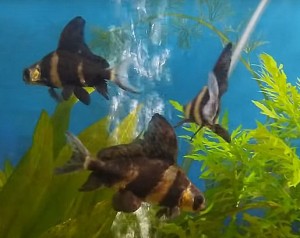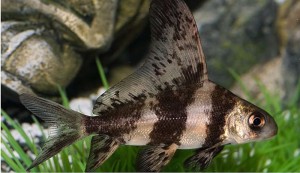The Chinese High Fin Banded Shark (Myxocyprinus asiaticus) is also known to tropical fish keeping enthusiasts as the Chinese Banded Shark, Chinese Sailfin Sucker, Banded Loach, High Fin Loach, Sailfin Sucker, Topsail Sucker, Asian Sucker, Chinese Sucker, Wimple Carp, Hilsa Herring, Asian Zebra High Fin Shark, Chinese Emperor, Siamese Sucker, Chinese Banded Shark , and Chinese Zebra High Fin Shark.
Regardless of it’s many common names, they have no relationship to actual sharks other than that they are fish.
Chinese High Fin Banded Shark (Myxocyprinus asiaticus) are one of only two known suckers that are found in Asia, the other being the Siberian Cotostomus rotratus. They originate from the highly aerated mountain streams in the Yangtze River of China and despite their size (up to 4’6″ in length) are popular community tank fish. Because of pollution and over collection for the aquarium trade, the Chinese High Fin Banded Shark has been placed on the endangered species list and is a state protected species in China.
Juvenile Myxocyprinus asiaticus have light to white bodies with three dark brown to black slanting bands that veer towards the rear of the fish and a high triangular dorsal fin that extends to the rear of the anal fin. Their colors change with their moods and as they grow into adulthood, usually around 12 to 14″ in length, they lose their white stripes and their bodies become more elongated, losing their distinctive high dorsal fin.
During the breeding season, adult males can be distinguished from the females by their more reddish coloration. Adult females become almost a dark purple in color and develop a broad vertical reddish area along their bodies.
Chinese High Fin Banded Sharks have thick fleshy lips with small papillae and a single row of pharyngeal teeth. They are docile, slow moving bottom dwellers that make perfect community tank residents and although they can be kept as individuals, they are frequently kept in small shoals in an aquarium environment. Because they are slow growing and long lived (up to 25 years) they will eventually require a large aquarium to keep them healthy.
Chinese High Fin Banded Shark are best kept in at least a 55 gallon aquarium with a sandy or fine gravel substrate that is densely planted and aquascaped with some driftwood or bogwood, and some rocks if desired. They can tolerate a wide range of temperature variations but because they are subject to abrupt changes in water quality and highly susceptible to nitrates; good aeration, regular partial water changes, and a good filtration system is necessary to keep these fish healthy and happy.
In nature, Chinese High Fin Banded Sharks migrate into the relatively fast flowing, shallow headwaters of the Yangtze River to spawn but as of this date, almost nothing is known about the breeding of the Myxocyprinus asiaticus other than it is believed that their breeding habits are similar to that of Cotostomus cotostomus.
The Chinese High Fin Banded Shark is easy to feed. In their natural habitat and in the aquarium, they are constantly on the move over the bottom searching for food. They can be fed a variety of foods such as brine shrimp (which makes the orange flecks in the fish’s coloration more pink), live, fresh or frozen bloodworms
, tubifex, prawn, earthworms, insects, crustaceans, small molluscs, annelids, algae, along with a quality sinking omnivore pellet or flake. If they should stop eating, it is usually due to water quality. Perform a water change and begin feeding them live foods only until they resume eating normally.
The Chinese High Fin Banded Shark (Myxocyprinus asiaticus) is not commonly available to tropical fish keeping enthusiasts however, they can be occasionally purchased from specialty fish shops or online at moderate prices, as juveniles.
Minimum Tank Size: 55 gallon
Care Level: Moderate
Temperament: Docile
Aquarium Hardiness: Moderately Hardy
Water Conditions: 65-82° F, 36 – 357 ppm, pH 6.0-8.0
Max Size: 4′ 6″
Color Form: Brown, White
Diet: Omnivore
Compatibility: Large community tanks
Origin: China
Family: Catostomidae
Life Span: 25+ years
Aquarist Experience Level: Intermediate




How does it make any sense to say these guys need at least a 55 gallon tank.. when you also state they get over 4 foot this is why fish like this should require a license to own, that teaches you proper care! These guys a need a very large pond that’s at least a 1000 gallons, being they should be kept in a group too.
Except for the licencing, I totally agree with your premise on keeping this species.
This is precisely why this website was created, to properly educate newcomers to the fishkeeping hobby on how to care for their fish.
Ponds are also appropriate for Arowanas, Red Tail Cats, Pirarucu, knifefish, Pacus, several species of Plecos, etc.
The government has far too much power over us right now without making us endure a licencing process to keep tropical fish, or any pet in general. (Endangered species excluded)
That was literally the very first thing I thought too!
This is the type of information that gets to beginners and causes big, sad and devestating issues.
Ugh.